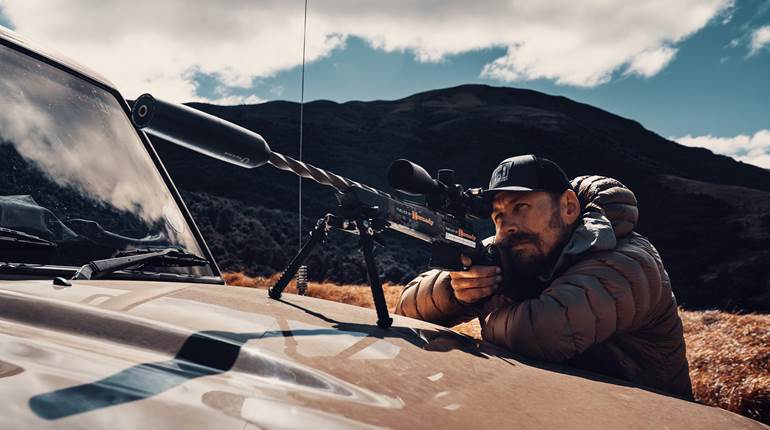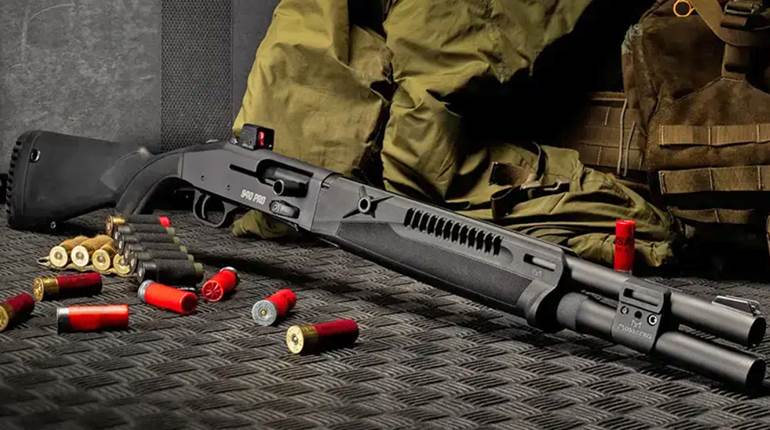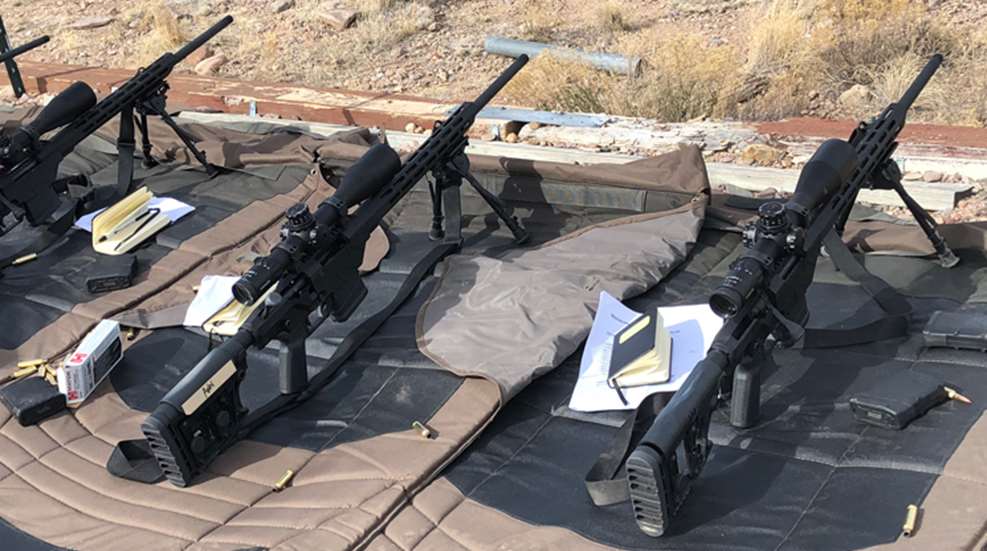
I grew up in the hills and hollers of West Virginia where my family taught me that guns were meant for one thing: shooting dinner. Hunting was passed down to me in the womb, literally, as my mother hunted while pregnant with me. Later, when I was old enough to hold a rifle alone, we would shoot at pie plates or cans, but that was only to make sure we were prepared to shoot at something tastier. Since then, I make it a point to stock my freezer every year. 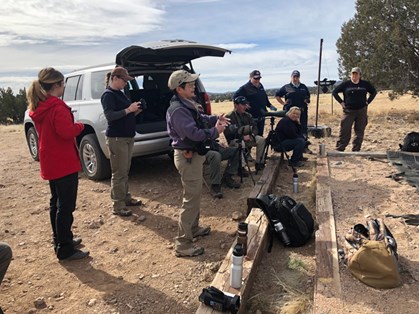
About seven years ago, I met a group of exceptional women during a firearm training event. Now we try to get together each spring and learn something new about shooting; this year the subject was long-range shooting with the new Mossberg MVP precision rifle. While shooting at paper has never been extremely important to me, I was not about to stay home and let them have all the fun. I was very excited to learn this new skill and spend more time with my friends.
This was a good plan, until I remembered that long-range shooting is done, for the most part, from the prone position. Even my slight disabilities would make it very difficult for me to spend much time in prone position. I started worrying whether I could do what was asked of me or even participate at all in the class. I worried that I would slow things down for the others and become a hindrance. I was doubting myself and becoming insecure. The world started feeling too big for a hillbilly from West Virginia, and I started feeling the pressure of performing adequately. I just couldn’t let them down.
Gunsite Academy in Paulden, Ariz., was founded in 1976 by Col. Jeff Cooper, who is known as the father of the “modern technique of the pistol.” Gunsite—like a theme park for gun training—has classrooms, a pro shop, gun smithy, numerous ranges for all distances and for different purposes, indoor and outdoor simulators, and is decked out with covered picnic tables, gun racks, delivered lunches, and bathrooms on the ranges with running water. The only thing that could have made it more exciting to me is if we had permission to hunt the jackrabbits, javelinas, and antelopes on the property. Hunting the cardboard creatures on the property is permitted with an instructor, although it was not on the agenda for our long-range shooting class.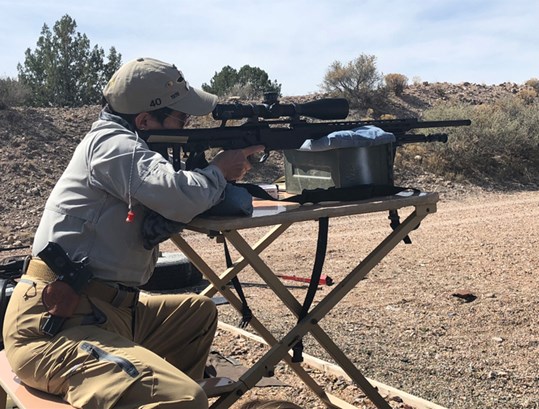
Renowned Gunsite instructor Il Ling New looks downrange through the Kahles 642i riflescope.
We arrived at Gunsite early on a cold Tuesday morning in March. Our instructors, Il Ling New and Mario Marchman, started organizing our group. In addition to the eight women shooters for the class, Mossberg’s chief engineer, Tim Blazek, and an engineer and long-range competitor, Jim Langley, were in attendance. Looking around the classroom, I realized that everyone in the room was an experienced shooter, and all had expectations of doing well. I was merely hoping that my hunting experience would translate over to an unfamiliar firearm, stationary targets, and distances that could throw a bullet off track with a simple puff of wind. I was worried that I would be the one struggling with a shot placement no more accurate than a game of pin-the-tail-on-the-donkey.
Geometry, trigonometry, physics, and math all seem to produce for me a side effect of general headache and foul mood. But I was thrilled to discover that Milliradians, Subtension and other calculations were not too difficult to understand—this coming from someone who didn’t know a Mil from an Arizona roadrunner. The calculations would be of greater importance to understand if one planned to be an Olympic shooter, and besides, these days there is a downloadable app to cheer up the day with automatic calculations. While the technicalities are important and very helpful for long distance, the science (as I was assured by our esteemed engineers) is not exact. Besides, what fun is it to know the outcome of every shot before you take it? Knowing that most any condition can affect the shot, be it wind, rain, temperature, velocity, barometric pressure, my itchy nose, and my math headache, rest assured that the shooter and her spotter are the most important elements of the equation.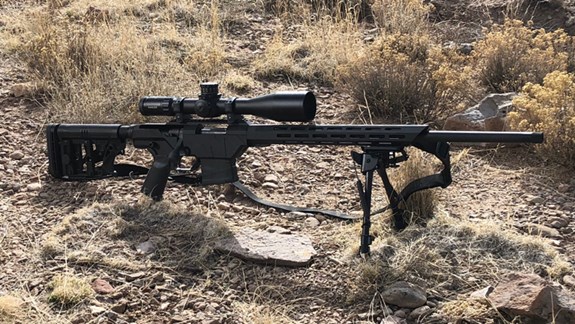
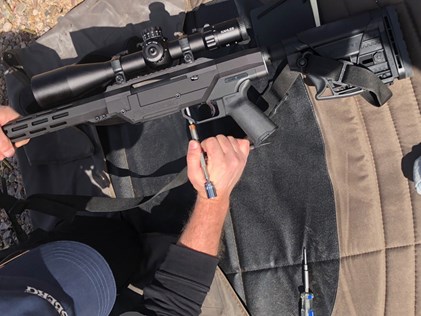 Part of our education was to become familiar with our equipment. What a treat it was to be handed a firearm, optics and ammo that were ready to be taken to the range. Mossberg supplied us with its new MVP Precision rifle in 6.5 Creedmoor. Ask anyone who knows me and they will tell you that I have no use for a rifle that doesn’t fit my frame (only a 12-inch length of pull). The MVP made adjustments to my size super easy. The length of the stock, as well as the buttplate and comb, all could be changed without the need for tools. Once the adjustments were made, these components were tightened down by simple twists and then locked by a simple screwdriver. The stock was easily removed without tools so that we could insert the bolts into the action. The hand tightened adjustments were tight and did not work loose even after firing about 200 rounds through the rifle.
Part of our education was to become familiar with our equipment. What a treat it was to be handed a firearm, optics and ammo that were ready to be taken to the range. Mossberg supplied us with its new MVP Precision rifle in 6.5 Creedmoor. Ask anyone who knows me and they will tell you that I have no use for a rifle that doesn’t fit my frame (only a 12-inch length of pull). The MVP made adjustments to my size super easy. The length of the stock, as well as the buttplate and comb, all could be changed without the need for tools. Once the adjustments were made, these components were tightened down by simple twists and then locked by a simple screwdriver. The stock was easily removed without tools so that we could insert the bolts into the action. The hand tightened adjustments were tight and did not work loose even after firing about 200 rounds through the rifle.
Mossberg has done a great job making its products compatible with standard components. The MVP, for example, is built on a chassis that sports AR-compatible magazines and a 20 MOA Picatinny rail for attaching optics and extras. I like being able to share magazines and other additions between rifles. My budget especially likes not having to buy extra parts. Speaking of budgets, Mossberg made this rifle extremely affordable at about $1,400 MSRP. While this might be more than I would pay for a hunting rifle, precision rifles can be pricey in comparison, and can run into the many thousands of dollars. Long-range competitor Jim Langley, who helped facilitate our three-day class, assured us that the MVP was a good and economical choice for competition shooting.
Getting my rifle, playing with the adjustments, and putting a piece of tape with my name on it was just like Christmas in springtime. I was happier than a cat chasing a laser. If someone would’ve checked my pulse, I would’ve probably been embarrassed. This shiny rifle was mine for three days and I was acting so proud that I momentarily forgot my worries. 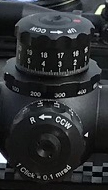
We moved on to the optics. Kahles provided the 624i riflescope for our use. I am not a fan of anything complicated, and this sucker looked complicated. However, when I was shown all the features for this optic, it was actually quite the opposite of complicated—this coming from a woman that has only ever sighted in her rifle by knowing how many “clicks” to turn the dial. The 624i altogether changed my idea about riflescopes. This one comes with left-side windage turret, parallax adjustment integrated in the elevation turret, and adjustable brightness illuminated reticle. Once we fired a few shots downrange and zeroed in, a few simple turns of the screw and our point of aim matching point of impact at 100 yards read zero on elevation and windage turrets. Elevation, windage and parallax were all easier to dial in than making a call on my smart phone. One tenth of a mil equaled one click on the turret, which made quick calculations and adjustments possible.
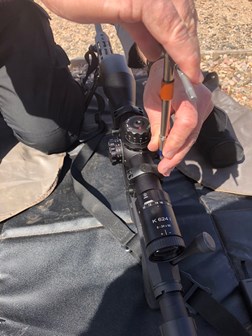
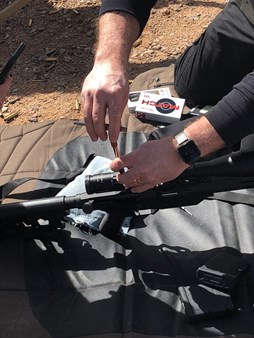
With the Kahles riflescope, the elevation and windage adjustment was spot-on accurate every time. I was beginning to get a clue at how easy it might be to hit a target at long distance with this setup. But, the proof, as they say, would be in the pudding. I didn’t use the lighted reticle as we were shooting every day in nice conditions. Besides, the lighted reticle looked so awesome that I became too excited fantasizing that I was aiming a 105mm from an M48 Patton tank. I figured it would be polite to dial down my geekiness. The Kahles scope is considered among the high end of optics, and has a price tag to match—but I think it is so worth it! Kahles, too, has other good options in lower price ranges, but it is not uncommon for precision shooters to budget more for their optics than their rifles. 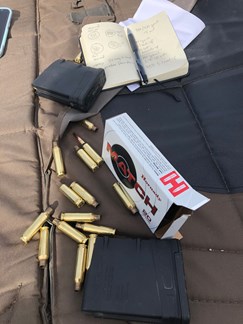
Hornady supplied our ammo, thus we loaded a variety of AR-style mags we had with 6.5 Creedmoor 140-gr. Hornady Match. Jim talked to us about how he, like most precision-rifle shooters, handloads for competitions. He said he enjoys getting into the technicality, having options and choices for his loads, and saving money by reloading, which makes a lot of sense for someone who shoots competitively. I admit, I am not so interested in ammo. Folks can spend hours contemplating coefficients, velocity and bullet performance. Believe me, I have heard them. But that conversation only lasts about three minutes with me before I spot a squirrel or something shiny. I’m still the same hillbilly woman that has been content to have my one reliable rifle and ammo that fills the freezer. Besides, with my indecisive nature, it would take me three months to handload the first round.
With our minds crammed full with calculations and up to speed on our equipment, and a small notebook in hand to write down our shooting information, we headed out to the range. Due to my disabilities, I opted to spend most of my time on a shooting bench rather than prone. This would come with some challenges such as not being able to “load the bipod.” I confess that I had never heard that expression before. It was clear from watching the others that loading the bipod by putting some body weight against the rifle to cause resistance against the bipod created a great deal of stability and control of the rifle. On the shooting bench, my bipod would slide or hop across the smooth table causing me to lose stability. In retrospect, it would have been great to have a bench with a raised edge that would anchor the bipod.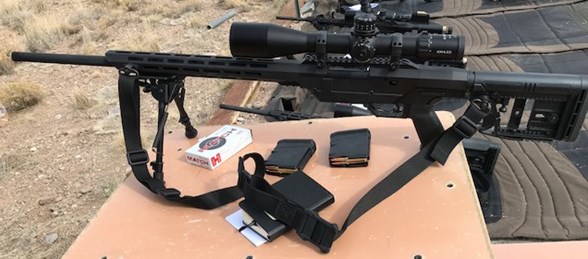
The author, limited in her ability to lie prone, propped her Mossberg MVP Precision rifle on a bench and had no trouble reaching out to 1,000 yards.
It was interesting to note that the comb on the stock of the MVP rifle was an initial source of discomfort for most of the women. Linda Powell, marketing director for Mossberg and hostess to our women’s group, knew immediately what was going on. Apparently women’s cheekbones are a little higher than a man’s. This means that the comb created too much height, making it difficult to get a cheek weld that easily allowed for aligning with the eye with the optic. Fortunately Mossberg made the adjustments so easy on the rifle that we were all able to adjust the comb to a comfortable position or remove it altogether without any tools. Problem solved, and Mossberg won my appreciation for a stock that could accommodate female shooters. 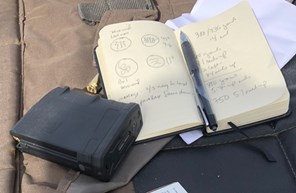
Our engineers were nice enough to run the calculations using an app to give us all our “Come ups,” or elevation adjustments, for most distances we were shooting. A few of the easier ones we were left to calculate on our own. This is where I learned about DOPE (Data On Previous Engagements). Our notebooks became full of information about each shot, the “come ups,” windage and other conditions. This helped us to quickly calculate adjustments as needed. Using DOPE, a “come up” of 2.4 mils at 500 yards and .7 mils at 300 yards, it wasn’t too difficult to quickly figure the “come up” required for 400 yards. Just split the distance between 2.4 mils and .7 mils to land at 1.5 mils for 400 yards. This is my hillbilly brain on DOPE.
We started off shooting slowly at 400 yards to make sure that everyone was up to speed on calculations, adjusting the optics, using the equipment, and actually making the shot. Out of our group of eight women, there were no misses! I can only account for this by knowing we had exceptional instruction and exceptional equipment as well as a group of exceptional women that I count myself lucky to be among. As we started moving out to longer distances, the wind also started picking up. Misses started becoming more frequent, but this was a good thing. This allowed us to learn to spot for each other by calling shot placement, to use our reticle to measure and adjust our aim, and to become familiar with how to read wind and make corrections on the fly. 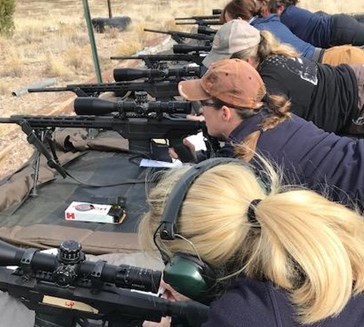
Before long, my partner and I were spotting for each other and shooting like a well-practiced team. Linda and I would confirm our Mil measurements and optics settings. She would give me the call such as “Hold left, Favor left, or Left 1 Mil.” My shot would come quickly following her instructions, and we would be rewarded with a hit on the target. Then we would switch roles. I would try to ignore what the wind was doing to my body and concentrate on what it was doing at the target. I would look for indicators such as dust, swaying grass, or moving trees and bushes. Then I would make the call. I rarely got to say “Center” (except at closer distances) as the wind was a factor every day on the range. But I would give a call followed by the report of her rifle. Most shots were followed by an exclamation of “Hit!” and a high five between us.
With more success, our group started some competitions between partners. We would start from prone or start from standing, quickly locate the target and make our elevation adjustments, start communicating our instructions, and pull the triggers. The team that made the hit first was the winner. Each team had success and we all had more fun than I would’ve ever imagined possible shooting at a target that I couldn’t later eat.
I will have to admit that this hillbilly woman has gotten out of the hills and found some sophistication. I no longer consider myself just a hunter. I am now a seeker of targets and skill. Having success at hitting the target has always been extremely satisfying. With a spotter-shooter team it is even better. The high five at the end says it all.
Whether you are a woman or a man interested in getting into long range shooting, do yourself a favor. Don’t risk getting frustrated a with trial-and-error approach. Get some good, dependable equipment. The Mossberg MVP, Kahles 624i, and Hornady were a perfect match up for me and the rest of our group. Also, find a reputable long-range shooting expert and make the science behind the sport easier to understand—preferably one who understands how to adjust equipment to fit an individual who may have high cheek bones and shorter lengths of pull if needed. I know where to find these instructors. After being trained by Il Ling New and Mario Marchman, I can’t imagine a better facility and and better instructors. Let me just say that changing a “one-rifle loving woman" to long-range shooter in just a few days is no small feat, especially when I didn’t know a Mil from an Arizona jackrabbit.
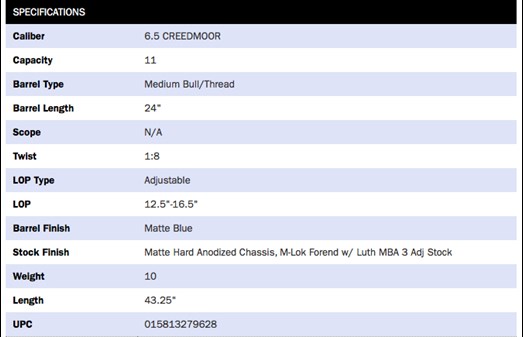
Images copyright AmericanRifleman.org












